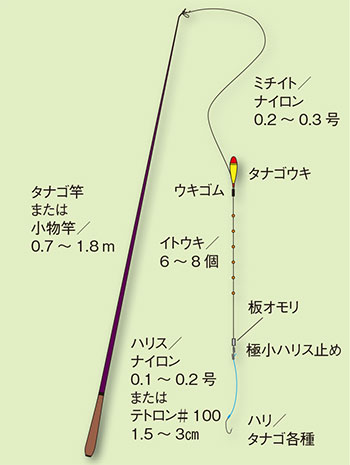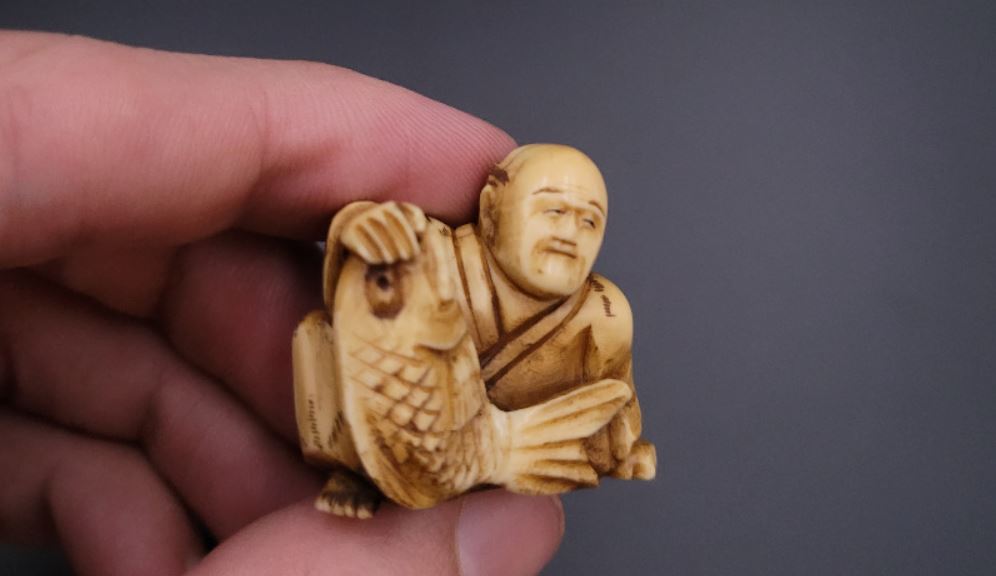The Small is Beautiful; World of Tanago Fishing
Is it fun to catch small fish? Yes, it is, especially for Tanago (Bitterling, Rhodeus ocellatus).
Fishing for Tanago
Using a whip rod of 1 m, its main line is 0.10mm, and the leader is 0.08mm. One uses a hook about the size of the head of a match. The popular rig is float fishing and the float is the size of a corn kernel.
Now, you have many questions floating around you about this tackle, I imagine. If you have any questions, please ask me from the comment form at the end of this page.
A paste bait is often used. Ingredients of the paste are flour, potatoes, rice, eggs etc. Other kinds of bait are from larvae of insects, inside contents of cocoons, larvae of midge (or mosquito) etc.
The angling itself is very simple. After the presentation, when you see the float moving, you raise the rod to hook fish. The difficult point is hooking. Compared to its body size, this fish has a smaller mouth. The balance is quite similar to freshwater bream. This small mouth lets anglers use such a special shaped hook. For this, much of float movements are not signaling the real bite. It is one of the joys of this fishing to give a proper strike to catch a fish correctly.

In Tanago fishing, everything is shrinked or is made smaller in anything. The most of the catch is around 4 cm, and tackle is optimized for the size. But once an 8 cm fish is on the hook, it is like a giant in a small world. Then, there comes the thrill and the game of saving the line from breakage suddenly.
Additionally, it is considered to be a great achievement to have over 100 pcs of fish on your palms, to praise the smallness of your fish and the number of fish you have caught.
Culture to embrace the small things
You may ask why is it fun to fish such a small fish. The answer may lie in the aspect of Japanese culture. Japanese people cherish small things.
You may have heard the word Bonsai. It is about an old small tree grown in a pot. For Japanese people, it is more than a tree. We think that the bonsai is expressing nature on a miniature scale. It is an art, aiming to represent aspects of nature on the pot.
If you are not familiar with it, please visit here; https://en.wikipedia.org/wiki/Bonsai.
In addition to Bonsai, there are things which show our adoration of small things. Netsuke (small accessory), Haiku (shortest poem form), Kaiseki (multiple small portions of various foods), Karesansui (Japanese dry garden) etc.

For Japanese people, representing reality in a small package is important. Tanago fishing is one such instance. We see the core of the fishing in it.
Species
There are many species of target in Tanago fishing. Among them the most popular one is Tairiku-bara-tanago (Rosy bitterling, Rhodeus ocellatus). Tairiku means the continent, and as the name shows, this is native to East Asia. It was brought into Japan around 1940’s,accidentally, with the importation of Silver carp (Hypophthalmichthys molitrix) as a food source, from China. There is a pure Japanese native species of Tanago, but it is mixed with continental species and it is hard to find the native one in Japan.
Tairiku-bara-tanago grows up to 6 to 8 cm, in areas with still or slow moving water, of flat low elevation lands. The typical places are such as small channels near rice fields.
As there are many rice fields all around Japan, it is not difficult to find a place in which Tanago may live. Additionally, this fish can adapt to any climate found here. It is said that one can find this fish in every prefecture in Japan. So, it may not be difficult for you to find such a place, when you visit suburban areas in Japan.
It is omnivorous and feeds on planktons and algaes. As the shape of the fish can tell some of you, it eats their food in all the depth range.
One of the most unique characters in this fish is that it lays eggs in certain kinds of shellfish.
Females have a special pipe shaped organ to do it. Baby fish give birth within the shell, and about one month later, they come out to the open water. On one side, this species depends on the shellfish for their eggs, and on the other side, this shellfish’s larvae parasite on the fish to grow.
This type of shellfish is seen only in the water with better quality. This symbiosis limits areas Tanago can be sustainable. Naturally, the conservation of it means the conservation of the shellfish at the same time. It gives a difficulty to have conditions good enough for it to dwell.
I hope you could feel the uniqueness of Tanago fishing, and the reasons why we love it. Why don’t you include this small-scale fishing in your next trip to Japan?

3 thoughts on “The Small is Beautiful; World of Tanago Fishing”